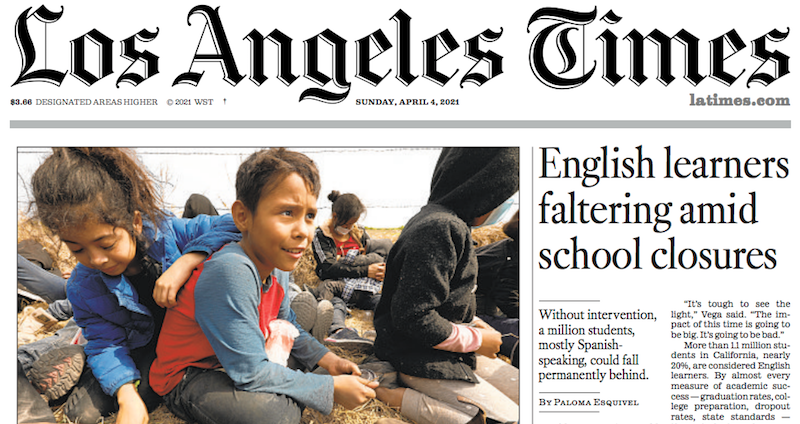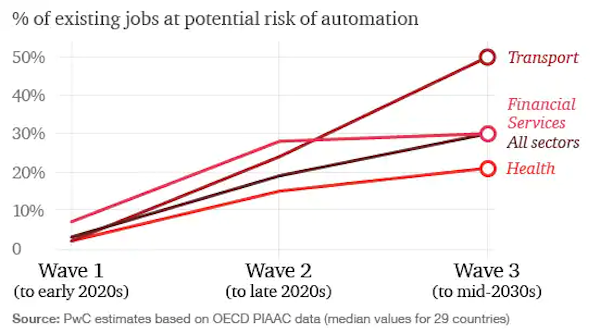More alarming in a way is how the article on the [...]]]>

More alarming in a way is how the article on the right indicates a failure of basic language learning among foreign and/or hispanic students. The piece omits certain helpful information, such as citizenship and time of residence, and instead concentrates on the problems caused by the pandemic.
But when a 13-year-old who has “attended Los Angeles schools since kindergarten” and still cannot speak English, the problem is something other than the virus.
The situations of education failure described are concerning, particularly with what’s coming in a few months — thousands of illiterate foreign children admitted via Biden’s open border will arrive and schools will have to cope. Previous diverse kid dumps have proved expensive to local school districts across the country.
Plus, another strategy of diversity enthusiasts has been to promote a bilingual America which has never been popular among citizens.
A looming catastrophe is about to strike America’s schools. Hopefully the press will report how citizen kids are directly cheated by Biden’s open border. They shouldn’t be forgotten in all the tiresome overdone media concern about foreign children.
The Los Angeles Times supplied hint of what’s coming (reprinted by Yahoo.com, below):
]]>In California, a million English learners are at risk of intractable education loss, by Paloma Esquivel, L.A. Times, April 4, 2021
Aida Vega’s 13-year-old daughter, who has attended Los Angeles schools since kindergarten and is in eighth grade, still struggles to read and write English.
Vega has long pushed for extra help so her child can master the language. Early last year, she felt confident that a breakthrough was at hand — her daughter’s teachers had a plan to start additional tutoring in March.
Then schools closed. Tutoring was canceled, except for a short stint during the fall semester. Vega says her daughter’s schooling became a constant struggle. There are days when Vega has found her in tears next to her computer. In the fall, after teachers said her daughter was failing all of her classes, Vega began taking jobs cleaning homes and offices to pay $45 an hour for a private tutor. But she worries her daughter is still falling behind.
“It’s tough to see the light,” Vega said. “The impact of this time is going to be big. It’s going to be bad.”
More than 1.1 million students in California, nearly 20%, are considered English learners. By almost every measure of academic success — graduation rates, college preparation, dropout rates, state standards — these students rank among the lowest-achieving groups. And that was before pandemic-forced campus closures. One year later, this massive population of students is at great risk of intractable educational loss, experts said.
“It’s an educational pandemic,” said Martha Hernandez, director of Californians Together, a nonprofit that advocates for English learners. “We already had issues of an achievement gap, opportunity gaps, lack of access, lack of equity. Now that’s just exacerbated, and it will be a huge challenge. It will have a big impact for many, many years.”
She and other experts, parents and educators say schools must make immediate and swift interventions to salvage the education of English learners — 80% of whom speak Spanish — including improving distance learning for those families that choose to continue online and extending the school year and school days to allow for additional learning time.
An abundance of reports in California and throughout the country show the dire toll distance learning has taken on these students.
The Los Angeles Unified School District educates about 120,000 English learners, or 20% of its students, and reported that in spring 2020 fewer than half of English learners in middle and high school participated in distance learning each week — a gap of about 20 percentage points compared to students who are proficient in English.
Last month, the district reported that 42% of grades earned by English learners in high school were Ds and Fs, an increase of 10 percentage points from the prior year — greater than any other group except homeless youth. Middle schoolers saw a 12 percentage point increase in Ds and Fs.
And fall interim assessment results indicate that more than 94% of the district’s English learners in middle and high school were not on grade level in reading and math, according to a report this week by the advocacy group Great Public Schools Now, based on district data. (Continues)
A couple days earlier, Breitbart previewed the [...]]]>
A couple days earlier, Breitbart previewed the programming: Report: ‘Huawei of Genomics’ Tried to Use Coronavirus Tests to Collect U.S. DNA Data, which noted:
[Bill] Evanina and other security experts warned specifically about the danger that if China can collect tremendous amounts of medical data about Americans, including their DNA, it could be able to monopolize the production of diagnostic equipment and medicines needed to treat them, gaining increasing amounts of leverage over the U.S. population, its government, and American industry. . .
The Chinese government is reportedly frantic to collect DNA from its own citizens, without giving any reasonable explanation for why it needs such extensive data.
Don’t we already know that allowing unfriendly Red China to produce medical supplies and pharmaceuticals for American use is a really bad idea because it endangers the health and safety of citizens? What’s new now?
In the current case, there has been a fair amount of media attention paid to a somewhat vague threat. Perhaps the press is holding back so it won’t be accused of anti-Chinese racism.

China expert Gordon Chang has been more specific about what Beijing might be cooking up. At around 4 minutes into the video below, Chang explained on Fox News’ Sunday Morning Futures what might be transpiring behind the curtain:
MARIA BARTIROMO: And you said that the most important thing to focus on is the gene editing — they’re making their military superhuman.
GORDON CHANG: Yes, well they’re talking about a new type of biological warfare of specific ethnic genetic attacks which means that the next disease from China could leave the Chinese immune, but affect only us and that means it could cripple societies around the world. So we’ve got to be concerned about the next disease, and Biden isn’t even challenging China on covid-19, so we’ve got to worry about where we’re going to be on the next pathogen.
During a December interview, Chang similarly opined, “China is probably trying to develop diseases that target not just everybody, but target only certain ethnic or racial groups.”
Whether the Wuhan virus was an accident or purpose-built, the world pandemic has worked out quite well for Red China — America has suffered a serious recession and President Trump was apparently defeated in a rather haphazard election. So why wouldn’t China cook up more of the same in the future, as Gordon Chang suggests? The next pathogen need not kill millions to cripple the nation, it just needs to sicken many of the people and upset the normal functioning of the economy.
]]>
More recently, the Wuhan pandemic has speeded up the process of businesses adopting smart machines, since robots also don’t get sick — so convenient rather than undependable humans with their annoying germs.
CNBC held a discussion among tech experts last month about smart machines in the Plague Year: How coronavirus could usher in a new age of automation:
There’s not a lot that can be done to deal with the job-killing Age of Automation we face, but it would make sense to end immigration, because most of the jobs that immigrants do can be done more cheaply by smart machines. In short,
Automation Makes Immigration Obsolete
Here’s a transcript of the discussion I cleaned up for easy reference:
]]>NARRATOR: Automation is coming for your job — at least that’s the fear among many workers — from burger-flipping bots to car-building robots, not to mention high-powered software taking on more and more administrative tasks. It seems like hundreds of skills are rapidly becoming obsolete in the US economy. A McKinsey study found that AI and deep learning could add as much as $3.5 trillion to $5.8 trillion in annual value to companies.
ANDREW YANG: Eighty percent or more of the jobs that make $20 an hour or less are at least potentially subject to automation.
NARRATOR: The economic shock of the pandemic hasn’t helped; human workers are vulnerable to diseases that robots aren’t, making it much easier and now cheaper to have a robot on staff that doesn’t require healthcare.
MARCUS CASEY: Businesses are kind of looking and seeing that humans can get sick from covid, but machines can’t.
MICHAEL HICKS: If you can eliminate the healthcare costs, the labor and wage tag that comes along with those folks and particularly in services — that’s a big competitive advantage.
NARRATOR: To put the increase in robotics in perspective: the U.S. had .49 robots per thousand workers in 1995 which rose to 1.79 robots per thousand workers in 2017, but automation isn’t just a robotics revolution. The rise in information technology and artificial intelligence or AI has also become an enabler of automation. AI can help navigate difficult challenges that previously only a human operator could handle. Of course, if you’ve encountered automated phone systems, it’s likely you personally experienced that automation still has a long way to go.
DARON ACEMOGLU: There’s nothing wrong with automation as long as it is part of a portfolio of technological changes, but its specific effects are not super good for labor.
NARRATOR: But the pace of technological change is accelerating, and the covid-19 pandemic could have acted as the accelerant. The Urban Institute estimates more than 8 million low-income jobs have been lost during the pandemic.
ROBERT LITAN: One of the reasons we have friction in our labor force is that when people get laid off they have a harder time finding a new job, and that’s been especially true in the last twenty years.
NARRATOR: High-skilled jobs such as finance managers, payroll managers and accounting roles face a 56 percent chance of being automated in the future. And according to Consulting.ca, up to 30 percent of oil and gas jobs could be lost to automation by 2040. One major problem in the US for workers is that workers are a tax burden for employers, whereas machines are actually subsidized.
ACEMOGLU: US tax code has been very automation friendly: the United States has always taxed capital more lightly than labor.
LITAN: I think the government is going to have to be more aggressive going forward than just simply relying on a growing economy.
NARRATOR: Automation was progressing before the pandemic hit, but the sudden financial pressure that businesses in the US encountered created the perfect storm to turn to automation. In previous recessions, enterprises looking to streamline their business practices turned to automation and in some cases the recession simply sped up what was already a long desired change.
LITAN: The conventional wisdom about the pandemic is that it has greatly accelerated all kinds of trends — AI, artificial intelligence, robotics and things like that — the movement toward those is certainly going to be accelerated post-pandemic for a simple reason: robots don’t get sick.
NARRATOR: In food service industries, industrial machines that helped with food packaging preparation or even serving have helped to ease the burden on human employees who are susceptible to disease. Companies are looking to vaccinate their supply chains to make them more efficient. Automation of processes helps to eliminate the need for more administrative staff and a less human-labor-reliant warehouse system means that when a co-worker calls in sick, half the office isn’t quarantined.
CASEY: Among those who are actually employed in some of these low-wage occupations in the future they’ll be downward pressure on their wages, right, because they’ll be competing with machines, and so I think there will be some competition there.
LITAN: If we’re not able to retrain people for new things, then the historical pattern has been that the people that benefit the most from automation are people that have IT skills. In the post-pandemic world, if you don’t have some IT skills you’re at greater risk of being disrupted and having your wages fall relative to other people.
NARRATOR: Both the Trump administration and the Biden campaign have proposals to advance job gains for workers that have become affected at least in part by automation.
JOE BIDEN: Whether your predictions are true about automation and self-driving trucks, these folks aren’t stupid: they listen, they understand and they’re scared to death.
LITAN: The Biden campaign has proposed making community college free and also providing money for apprenticeships. The Trump administration has advocated more money for apprenticeships and so forth, but I think as a society the need to help people transition to new jobs is going to be much greater in the post-pandemic world than the one that existed just six months ago.
NARRATOR: The key to a post-pandemic world is a vaccine for covid-19. Recent vaccine candidates have continued forward in clinical trials, and there is hope that if the US can field a vaccine quick enough, the economic recovery could slow down some automation trends that have spiked due to the outbreak.
LITAN: But I don’t think enough thought has been given to how to get enough people — and I think it may take as many as 80 percent — enough people in the population to take the vaccine, so that we can get herd immunity and get our economy back to normal. And then these trends that we’re talking about — the AI trends and automation — they’ll kick in later, but we need to get back to normal before we even get to the so-called longer term trends.
NARRATOR: The clock can’t be turned back on technological advancement. AI research is steadily increasing and US investment ranged between 15 billion to 23 billion in 2016 alone.
HICKS: In the long run you know, better productivity leads to more economic growth, leads to higher wages for everybody. So there’s really no doubt in the long run automation, the story of it for the past 300 years, has been a happy one. In the short run for workers who are displaced, we generally don’t see wages recover, certainly not quickly. We see more effects transmitted to their families as well —more problems finishing school or behavioral issues.
NARRATOR: According to a Deloitte study, 50 percent of all jobs are potentially open to automation in the coming decades and according to McKinsey, 400 million workers could be replaced by automation by 2030 which is about 15 percent of the global workforce. Automation isn’t all doom and gloom; some are hopeful that if automation takes over lower skilled tasks, it could open up opportunities for fewer work hours and more free time that could be focused on creative pursuits that could actually result in even more economic growth.
CASEY: There’s certainly ways that the government can kind of step in and actually support the reskilling of workers who’ve lost their jobs — right, you know they can form public-private partnerships, support people going back to school or investing in more specialized skill sets within industries, help them move across industries from areas that have been hit hard by the pandemic to sort of more emerging areas. So that’s one set of policies. The other set of policies is to actually provide incentives for firms to actually do a lot of this work themselves.
HICKS: Well in general, automation is important because it brings higher productivity to workers, and it allows us to do more at lower costs. And so in general on average, it’s going to be a great boom to us. The challenge I think is during the transition, both for individual workers and the communities in which they live you could see some disruption from this, particularly I think among lower income or less well trained workers who have fewer skills to transition in an automated environment.
NARRATOR: One proposal to help offset job loss from automation is the concept of universal basic income or UBI.
YANG: The freedom dividend makes the case to our fellow Americans that we all have intrinsic value as people, as citizens, as human beings.
NARRATOR: Some UBI plans include a roughly $1000 monthly payment to every adult in the country with no strings attached. Detractors have argued that UBI would cause a drop in economic activity because it would disincentivize work. Other arguments contend that it is not feasible financially for the US government to dole out large sums of money to such an extreme number of citizens.
LITAN: We’ve done sort of a temporary UBI in the course of this pandemic, you know we sent out the $1200 check, or as we talk now, Congress is debating whether to send out another one. I don’t think that’s permanently sustainable from a fiscal point of view.
NARRATOR: Finland recently ran a UBI study and concluded that it did not create a disincentive for citizens to work. The study compared 2,000 people on UBI versus 173,000 on unemployment benefits over a two-year period. People who were on UBI reported feeling better mentally about their well-being compared to those on unemployment benefits. Researchers also noticed that those on UBI saw a higher increase in employment but remained unsure on the causes behind that trend.
LITAN: I think handing out money to everyone regardless of their circumstances is simply going to cost too much, especially in the in the light of all the additional debt that we’ve taken on.
CASEY: And we might get a better bang for our buck than just you know giving out checks every month to people who haven’t lost their jobs because there’s also a you know externality effects associated with that. Right, most people I think want to work, they want to build human capital and that’s building our productive base going into the future. So it has a short-term static issue like during the pandemic. Yeah, I’m fine with that — having a short run sort of universal basic income because people can’t work because of the pandemic makes sense. I’m not sure yet, I mean I don’t think the evidence is quite in that this is a very viable long-term strategy relative to some of the other ways that we could invest that money.
ACEMOGLU: I think it’s too late to reverse job losses from automation in the same way that it’s too late to reverse the job losses that happened from say import competition from low-wage firms from China, but we can be forward looking and have a better strategy for dealing with the continuation of this.
NARRATOR: Older workers appear generally less able to pivot into new careers that require learning new skills.
HICKS: The challenge that we see isn’t a 23-year-old learning new technology; it’s a 43 or 53-year-old.
NARRATOR: Part of the problem could be the way our educational system is designed.
HICKS: I think a bigger challenge one that’s going to be more long-term though is to address educational issues early on so the the ability to transition tasks for adult workers is really a matter of middle school math and language arts, so if you focus on those sorts of skills to make sure that the children don’t go into their high school years unprepared, I think you’re really creating a class of workers that are better able to adjust to new technology.
NARRATOR: Up to 14 percent of the global workforce may be forced to change careers by 2030 because of automation.
LITAN: I’m an advocate of lifetime training accounts so that people could borrow and then pay back based on their income in order to get training certificates or certificates to qualify them for new jobs and so forth.
NARRATOR: And 66 percent of respondents to a McKinsey survey of executives said that addressing skills gaps among workers was a top ten priority due to technological change.
MARCUS: Right now our tax code sort of supports the investments in capital right and not labor, and so if we could you know put some policies on the books that actually provide firms the incentive to actually invest in labor rather than capital that might actually help as well.
NARRATOR: The future of the American worker is far from written. As automation grows, political solutions could be used to stem the economic pain of a workforce facing an uncertain future.
HICKS: I think the focus was wrong, I mean the focus of the fear of automation should really be a focus on the educational deficits of a portion of our workforce. So we shouldn’t be afraid of automation. It’s going to come whether or not we like it we should embrace it the real public policy challenge is not to stop automation it’s not to be worried about it it’s to be worried about making sure that all of the citizens of the country, all of our workforce, every family has the skills to maneuver effectively in a world that’s more automated or sees more productivity growth which affects labor demand.
LITAN: Both Trump and Obama administrations relied heavily on just having a growing economy absorbing new workers and eventually the tighter the labor market became wages started to go up because employers were bidding for them, and I don’t think that there were a lot of super special efforts to accelerate the transition. I think both administrations rely heavily on just a growing economy in general. I don’t think that’s enough especially in the post-pandemic world. We’re going to need much more affirmative, more active government assistance to get people into new jobs.
ACEMOGLU: There is a notion that has developed over the last several decades that technology is an inevitable path that we’re just following that path, and anything else we try is futile, and I think that’s deeply mistaken and misleading. Technology is what we make it to be. We have a technological problem platform and a knowledge accumulation and we can use these for creating different types of technology automation is just one of them automating everything and making machines produce everything and sidelining humans is just one very peculiar path we don’t have to follow that path that doesn’t mean turning our back on ai doesn’t mean turning our back on digital technologies but it means that looking forward we have to take ownership of the path of technology.
Called the “No Chinese Handouts In National Assistance Act” or “No CHINA Act” for [...]]]>

Called the “No Chinese Handouts In National Assistance Act” or “No CHINA Act” for short, the bill’s aim is simple enough:
To restrict the use of funds made available in appropriations Acts for fiscal year 2020 for the benefit of any United States or foreign person subject to the control of the People’s Republic of China.
It’s good news that the China threat is becoming more widely understood in Washington. Too bad it took a worldwide pandemic to get the message across.
]]>TUCKER CARLSON: Chinese business has penetrated big parts of the US economy; they control much of it, and many American companies now have Chinese ownership. Congressman Matt Gaetz represents Florida. He’s worried that a bailout will wind up enriching the Chinese and helping the Chinese government.
He joins us tonight. Congressman, tell us what your concern is and how you plan to address it.
CONGRESSMAN MATT GAETZ: Radisson hotels, AMC movie theaters, even the Waldorf Astoria New York are controlled by China in essence, and I think we ought to restore every American worker and American small business before borrowing money from China so that we can then give it to China to then pay China back with interest after the Chinese virus.
That seems like a foolish thing that a great nation would never do. I’ve introduced legislation to block bailouts to corporations that are controlled by China. It’s so obvious I can’t even believe it’s not the law already.
CARLSON: They unleash a pandemic on the world. We wind up sending them tax dollars — why would that be a controversial thing to propose?
GAETZ: China has a lot of influence, and the companies that seek Chinese investment also have that influence, but this is a time that we can actually put America first — the needs of our people and our businesses.
This should be the easiest time in the world to ensure that we are making reinvestment in the American economy and that we are not the world’s fools by borrowing money from a country in the bond market, recycling it back to them and then charging the next generation of Americans interest on that money. We cannot do that. Congress should include my No China Act in the ultimate relief package.
CARLSON: It seems very obvious. One quick thing before you go according to Bloomberg reporter Steven Dennis, there’s a major roadblock to finishing the Senate’s coronavirus bill. Democrats want Planned Parenthood and other abortion clinics to get bailout dollars; obviously they already received Medicaid funding they’re not at risk of going over going under. Is this real for one thing?
GAETZ: There’s a never-ending list of these virtue-signaling items that the left is trying to tuck into this bill. Jim Clyburn who is a leader in the Democratic House said we ought to use the coronavirus as an opportunity to see through our vision for the country. Can we just for a moment take a pause in trying to socially engineer America and actually get resources in the hands of desperate Americans who are worried about how to buy food and clothing for their children?
CARLSON: Last question, 15 seconds — Senator Richard Burr hid what he knew about coronavirus in the country, lied about it and saved his own portfolio instead. Is he gonna stay in the Senate, do you think?
GAETZ: Richard Burr is a disgrace. He should be removed as the intelligence chairman immediately as a result of this conduct, and as Republicans in the Trump era we have an obligation to say that we do not want corrupt acts to be associated with our tribe, and Republicans need to start stepping up and speaking out because what Richard Burr did in the Senate stock sell-off is not something that we want our brand associated with.
CARLSON: God bless you for saying that. I wish more people had the clarity and the bravery to say that. Matt Gaetz, great to see tonight.
As [...]]]>
As a result of the fake epidemic, the stock market has dropped by thousands of points with trillions of dollars lost to investors. The NBA has shut down for the season after one player in the Utah Jazz tested positive for corona. The travel industry has been hard hit, with airlines losing passengers and the president’s 30-day travel ban adding to that. Colleges are sending students home where they will take their classes online.
The list of business casualties could go on and on, given the major assault of the media against Trump’s successful economy. Clearly the press cares zero about the human pain they are creating in terms of job layoffs and the huge disruption to normal society.
Conveniently for Democrats, the presidential election is just eight months off, and the left hopes the corona troubles will succeed in ousting President Trump when impeachment failed.

Note to New York Times — not everyone has been fooled by the full court media press on the corona fraud. Yes there is a communicable disease out there, but it is hardly worth the crazed reaction. On March 9, the number of deaths in the US was 26, with an average age of 77. A report from March 11 put the deaths at 37 with the average age being 78.
On March 11, the World Health Organization (WHO) designated the corona disease a pandemic. For a little history, NBC observed:
The last pandemic was the 2009 swine flu, caused by the H1N1 virus. That pandemic, which was first detected in Mexico, killed an estimated 200,000 people and hit young adults and children hardest.
The coronavirus pandemic is killing mostly older adults with underlying health conditions. As of Wednesday, there are more than 120,000 confirmed cases of COVID-19 in 114 countries, with 4,373 deaths.
So clearly the use of the word “pandemic” has become degraded and politicized now.
For an even bigger pandemic than the swine flu, there was the 1918 influenza (aka the Spanish flu) that swept the world, killing 600,000 in America alone. A couple years back, PBS made a film about the event, Influenza 1918. Here’s a clip:
So America has suffered genuine pandemics, but that is not the situation we have now. Instead, the liberal press is overstating a relatively minor public health threat in order to ruin the American economy in hopes of taking down President Trump.
And people who don’t accept the propaganda are in denial of the approved liberal narrative, according to the Times.
]]>How Right-Wing Pundits Are Covering Coronavirus, New York Times, March 11, 2020
Sean Hannity used his syndicated talk-radio program on Wednesday to share a prediction he had found on Twitter about what is really happening with the coronavirus: It’s a “fraud” by the deep state to spread panic in the populace, manipulate the economy and suppress dissent.
“May be true,” Mr. Hannity declared to millions of listeners around the country.
As the coronavirus spreads around the globe, denial and disinformation about the risks are proliferating on media outlets popular with conservatives.
“This coronavirus?” Rush Limbaugh asked skeptically during his Wednesday program. “All of this panic is just not warranted.”
The Fox Business anchor Trish Regan told viewers on Monday that the worry over coronavirus “is yet another attempt to impeach the president.”
Where doctors and scientists see a public health crisis, President Trump and his media allies see a political coup afoot.
Distorted realities and discarded facts are now such a part of everyday life that the way they shape events like impeachment, a mass shooting or a presidential address often goes unmentioned.
But when partisan news meets a pandemic, the information silos where people shelter themselves can become not just deluded but also dangerous, according to those who criticize conservative commentators for shedding any semblance of objectivity when it comes to covering the president. (Continues)
It seems there is a belief on the right that “the media and some politicians are playing up the threat of coronavirus to hurt President Trump.”
Wherever would these citizens get such an idea?
[...]]]>It seems there is a belief on the right that “the media and some politicians are playing up the threat of coronavirus to hurt President Trump.”
Wherever would these citizens get such an idea?
Perhaps they have seen Dr. Drew Pinsky on TV pointing out the crazy discrepancies of press attention to the flu in the United States with around 18,000 dead this year versus the coronavirus’ 26 deaths as of today. Nineteen deaths occurred in a Seattle nursing home, which should be a hint about the group most endangered.
There is a pattern to corona deaths, but it is confined to those already old and feeble, not the general public. Yet the media would have us believe that a couple dozen deaths of the elderly portend a nationwide pandemic in the near future from the virus.

Dr. Drew appeared on CBS New York a few days ago:
DR. DREW: “A bad flu season is 80,000 dead, we’ve got about 18,000 dead from influenza this year, we have a hundred from corona. Which should you be worried about influenza or Corona? A hundred versus 18,000? It’s not a trick question. And look, everything that’s going on with the New York cleaning the subways and everyone using Clorox wipes and get your flu shot, which should be the other message, that’s good. That’s a good thing, so I have no problem with the behaviors. What I have a problem with is the panic and the fact that businesses are getting destroyed that people’s lives are being upended, not by the virus, but by the panic. The panic must stop. And the press, they really somehow need to be held accountable because they are hurting people.”
Dr. Drew has been a rare voice of sanity during a mass media panic attack which is having negative affects in the stock market and many businesses.
Nothing on television that I’ve seen has discussed the demographics of those killed by the illness. But a Google search for Average Age of Coronavirus Deaths in America brought up the following:
Everything we know about the 26 coronavirus deaths in the U.S., KXAN, March 9, 2020
. . . But a breakdown of the deaths do offer some guidance as to which people are most at risk. Based on a rough estimate using the range of ages given for the victims, we can tell that the average age of each victim is approximately 77 years old.
No one younger than 40 has died from the disease in the U.S. Deaths skew much older. And even the one person in their 40s who did die had an underlying medical condition. . .
Meanwhile high school events are being postponed out of “an abundance of caution.” More like an abundance of media-induced hysteria.
But if America can rack up a few dozen additional deaths, the press will probably name the illness the Trump Pandemic.
]]>